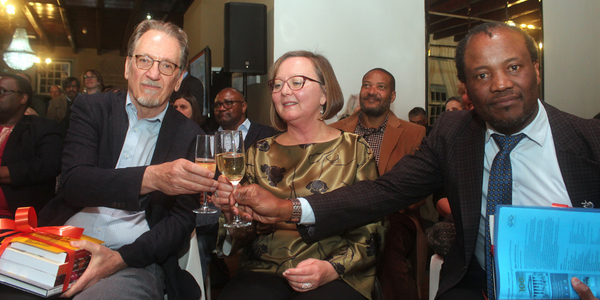1575 book titles in 100 years
- Wits University
Wits University Press is the oldest university press in South Africa and celebrates its centenary in 2022.

Wits Press hosted a champagne and canapés centenary soirée at the Wits Club on 25 August, at which one of its latest publication, Wits at 100: From excavation to innovation, was revealed.
A veritable Who’s Who of scholarship, academia, and publishing, around 120 people attended the Wits University Press centenary celebration.
A twitter of literati
Distinguished guests from Wits included Professor Zeblon Vilakazi, Wits Vice-Chancellor and Principal; Dr Daisy Selematsela, Head of Wits Libraries; Wits authors including Professors Susan Booysen, Marcus Byrne, Nicky Falkof, Khwezi Mkhize, Hlonipha Mokoena, and Amanda Esterhuysen, amongst others.
Partners in publishing who attended included Mbongiseni Buthelezi, Executive Director of the Public Affairs Research Institute; Christo De Klerk, Vice-President of BlindSA; Samukelisiwe Mfuphi, National Coordinator of the Academic and Non Fiction Authors Association of South Africa; Sarah Mosoetsa of the National Institute for the Humanities and Social Sciences; Mpuka Radinku, Executive Director of the Publishers Association of South Africa; and Lazarus Serobe, MD of the Dramatic, Artistic and Literary Rights Organisation, amongst others.

A Press for a research-intensive University
Chairman of the Wits Press Board and Dean of the Faculty of Humanities, Professor Garth Stevens, was Master of Ceremonies:
“Over the last decade I’ve been inspired to see how Wits University Press has evolved and adapted to changes in the higher education sector, to changes in technology, and in the knowledge project broadly. And it has been fantastic to watch how they have engaged in debates on decolonisation and decoloniality and what it means to be a publisher in a research-intensive university today, and championed the importance of supporting a university press at a top-tier institution such as Wits,” said Stevens.

Wits Press Publisher, Veronica Klipp, regaled guests with archival anecdotes of Wits Press’s origins and trajectory over a century.
Quoting the late Professor Bruce Murray, who wrote two official monographs of the history of the University and who, in Wits: The Open Years, A History of the University of the Witwatersrand, Johannesburg, 1939–1959, wrote: “While a small-scale, under-funded operation, WUP [Wits University Press] was none the less responsible for a series of important publications.”
Klipp said, “This is a rather underwhelming assessment, given that the Press had published more than 1000 titles in its first seventy-five years, but it is probably an accurate reflection of its activities at that time.”
That time, a century ago, at the first ordinary Senate meeting on 27 March 1922, a proposal for the establishment of the University of the Witwatersrand Press was approved. A publications committee was set up to oversee its activities and to assess the academic merit of submitted manuscripts.
The primary function of WUP was “to make available in printed form the research work and scholarly or scientific writings of members of staff”.
Just as mining is integral to Wits University, so too did it permeate early publishing. The first book publication carrying the imprint of the Wits Press was The National Resources of South Africa by Wits Professor of Economics, RA Lehfeldt.
“The School of Mines and Technology and the Witwatersrand Council of Education had already been publishing what we’d consider to be scholarly books,” said Klipp. “In 2021 we sold books to 31 countries. In short, the publication of quality local research for a global audience remains a key principle driving the Press today. By the end of this year we will have published 1575 titles. We hope to publish many more important books in Wits Press’ next century,” said Klipp.
Wits University at 100: From excavation to innovation
Similarly, Wits University’s centenary book published by Wits Press and titled Wits University at 100: From excavation to innovation, is a nod to the University’s deeply entrenched roots in mining and in Johannesburg.

The book, unveiled for the first time at Wits Press’ centenary event, outlines the University’s origins as the South African School of Mines, which was established in Kimberley in 1896 and transferred to Johannesburg as the Transvaal Technical Institute in 1904. The Institute became the Transvaal University College in 1906 and was renamed the South African School of Mines and Technology four years later. Full university status was granted in 1922, incorporating the College as the University of the Witwatersrand, Johannesburg.
Wits University at 100: From Excavation to Innovation captures important moments of Wits’ story in celebration of the University’s centenary in 2022. It explores Wits’ origins, the space and place that it occupies in society, and its innovation agenda for its next century.
Furthermore, in September 2022, Wits Press will republish Murray’s two monographs: Wits: The Early Years, A History of the University of the Witwatersrand, Johannesburg, 1896–1939, first published in 1982, and Wits: The Open Years, A History of the University of the Witwatersrand, Johannesburg, 1939–1959, first published in 1997.
A Press that embodies the lifeblood of Wits
Eminent author and Distinguished Professor in Creative Writing in the School of Literature, Language and Media at Wits, Ivan Vladislavi? delivered the keynote address.
The author of The Restless Supermarket, which won the Sunday Times Fiction Prize in 2002, said: “These past few weeks, I have been time-travelling in the Wits University Press archive. It is a collective memory of a sort, incomplete and inconsistent, as memories usually are, but full of interesting things.”
Although Vladislavi? is not a Wits Press author, he found in the archives the publications that he has edited for the Press over the years.
“The 1 500 titles on the list, chosen for publication by many different people in very different eras, provide a sample of the ideas that have preoccupied the scholars associated with Wits since its founding, what they thought, argued, discovered or disputed,” he said.
“They also show what the University press, and to some extent the University itself, thought worth preserving and communicating to the world; and more broadly what the society valued or discounted.”
Vladislavi? said that his archival time-travelling suggested that Wits Press publication output peaked in the 1970s and 80s, when no fewer than 770 titles appeared – more than half the total to date.
“The focus of the publishing in these prolific decades – according to my quick survey – was on Geology and Hydrology – reminders of the origins of the University and of Johannesburg itself.”
Vladislavi? concluded: “Wits Press is very much part of the local publishing industry … It publishes for both the local and the global markets, and for many years has taken on authors from beyond the University and the country. It now produces 20 to 25 titles a year, many of them in the Humanities and Social Sciences. In recent years, the focal points have been gender, psychology, decolonization, and the politics of knowledge generally. Wits Press embodies the critical reflection and exchange that are the lifeblood of the University.”
Wits Press Fun Firsts
Did you know?
- The first black author published by WUP was the Reverend John Henderson Soga, whose book The South Eastern Bantu, first appeared in English in 1930.
- The first book by a woman was Maria Breyer Brandwijk’s On the phytochemistry of some South African poisonous and medicinal plants in 1938, followed in 1947 by the anthropologist Hilda Kuper’s The Uniform of Colour. (Kuper is referred to as a ‘Sometime lecturer’ on the title page as married women were not allowed to have permanent appointments).
- Author BW Vilakazi was the first black teaching staff to be appointed at Wits, though only as ‘language assistant’ and not as lecturer – even after becoming the first black person to attain a DLitt degree in 1947. Vilakazi’s second book, Amal e’Zulu, is considered one of the top 100 African books of the twentieth century, and it became one of the Press’ top sellers in the apartheid era as a set work in schools, with 96 000 units printed between 1945 and 1980.
- The first book was printed in Braille in 1950. This was an extract from the Satyricon translated by GJ Acheson.
